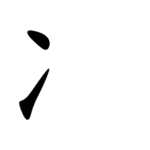

| 冫 | ||||
|---|---|---|---|---|
| ||||
| 冫 (U+51AB) "ice" | ||||
| Pronunciations | ||||
| Pinyin: | bīng | |||
| Bopomofo: | ㄅ一ㄥ | |||
| Wade–Giles: | ping1 | |||
| Cantonese Yale: | bing1 | |||
| Jyutping: | bing1 | |||
| Pe̍h-ōe-jī: | peng | |||
| Japanese Kana: | ヒョウ hyō (on'yomi) こおり kōri (kun'yomi) | |||
| Sino-Korean: | 빙 bing | |||
| Names | ||||
| Chinese name(s): | 兩點水/两点水 liǎngdiǎnshuǐ | |||
| Japanese name(s): | 二水/にすい nisui | |||
| Hangul: | 얼음 eoreum | |||
| Stroke order animation | ||||
 | ||||
Radical 15orradical ice (冫部), meaning ice, is one of 23 of the 214 Kangxi radicals that are composed of 2 strokes.
In the Kangxi Dictionary, there are 115 characters (out of 49,030) to be found under this radical.
冫 is also the 18th indexing component in the Table of Indexing Chinese Character Components predominantly adopted by Simplified Chinese dictionaries published in mainland China.
Note that in modern Traditional Chinese, Simplified Chinese and Japanese, radical ice in some characters (e.g. 冬, 寒) is now written as two dots. Their original forms are retained in Korean hanja and some old Traditional Chinese typefaces (e.g. 冬, 寒).
| Strokes | Characters |
|---|---|
| +0 | 冫 |
| +3 | 冬 冭 冮 冯SC (=馮 -> 馬) |
| +4 | 冰 (ice[1]) 冱 冲SC/variant (沖 -> 水 / 衝 -> 行) 决SC/variant (=決 -> 水) 冴 |
| +5 | 况SC/variant (=況 -> 水, condition[1]) 冶 冷 冸 冹 冺 |
| +6 | 冻SC (=凍, to freeze[1]) 冼 冽 冾 冿 净SC (=淨 -> 水, clean) |
| +7 | 凁 凂 凃 |
| +8 | 凄 凅 准 凇 凈 (=淨 -> 水) 凉SC/variant (=涼 -> 水, cool) 凊 凋 凌 凍 凎 |
| +9 | 减SC/variant (=減 -> 水, reduce) 凐 凑SC/variant (=湊 -> 水, gather) |
| +10 | 凒 凓 凔 凕 凖 (=準 -> 水) |
| +11 | 凗 |
| +12 | 凘 |
| +13 | 凙 凚 凛SC/JP variant 凜TC variant |
| +14 | 凝 凞 |
| +15 | 凟 |
In both Unihan database and mainland China's standard,[2] the Simplified Chinese character 习 (=習) falls under radical second (Unihan: 乙部, China: 乛部 or its variant form 𠃌) instead of radical ice.
|
Chinese radicals according to the Kangxi Dictionary
| |
|---|---|
| 1 stroke |
|
| 2 strokes |
|
| 3 strokes |
|
| 4 strokes |
|
| 5 strokes |
|
| 6 strokes |
|
| 7 strokes |
|
| 8 strokes |
|
| 9 strokes |
|
| 10 strokes |
|
| 11 strokes |
|
| 12 strokes |
|
| 13 strokes |
|
| 14 strokes |
|
| 15 strokes |
|
| 16 strokes |
|
| 17 strokes |
|
See also: Kangxi radicals | |
|
Simplified Chinese characters radicals (indexing components)
| |
|---|---|
| 1 stroke |
|
| 2 strokes |
|
| 3 strokes |
|
| 4 strokes |
|
| 5 strokes |
|
| 6 strokes |
|
| 7 strokes |
|
| 8 strokes |
|
| 9 strokes |
|
| 10 strokes |
|
| 11 strokes |
|
| 12 strokes |
|
| 13 strokes |
|
| 14 strokes |
|
| 17 strokes |
|
GF 0011-2009 Table of Indexing Chinese Character Components prescribes 201 principle indexing components and 100 associated indexing components (in brackets) used in Simplified Chinese. Not all associated indexing components are listed above. | |